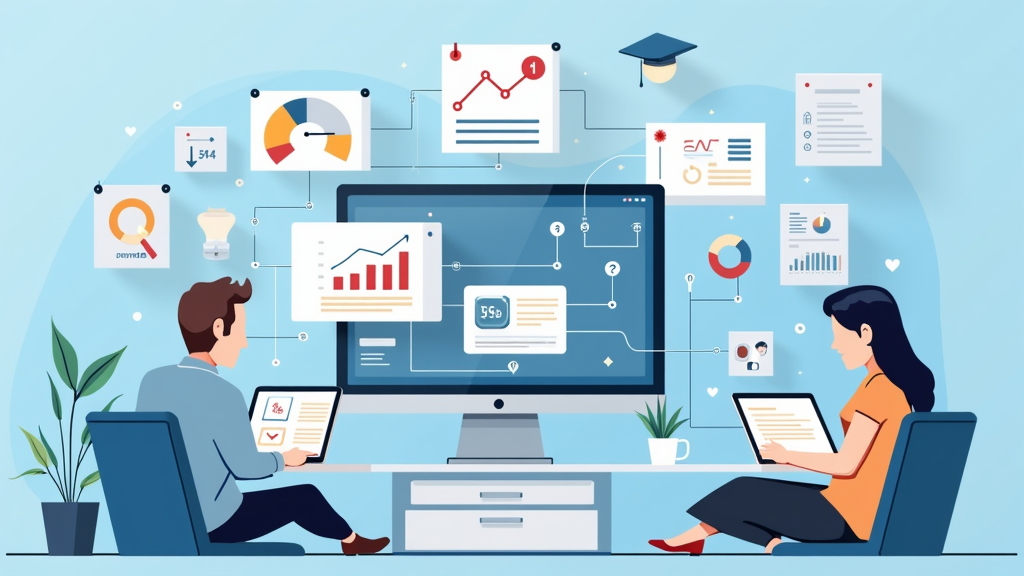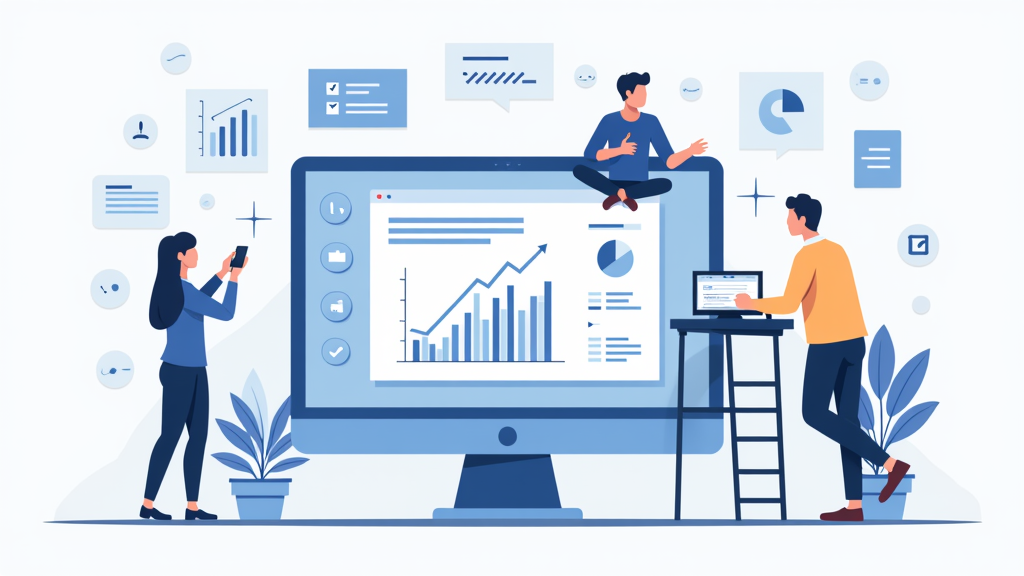Table of Contents
- Crafting Your Marketing Automation Outline
- Crafting Your Marketing Automation Outline: Key Concepts
- Key Components in a Marketing Automation Outline
- Detailed Guide to Your Marketing Automation Outline
Crafting Your Marketing Automation Outline

Understanding the Core of Marketing Automation
Marketing automation involves using software to automate marketing tasks across multiple channels. This encompasses a wide range of activities, from sending automated emails to managing social media posts, all with the goal of streamlining your marketing efforts.
The marketing automation sector is experiencing substantial growth, especially with the integration of artificial intelligence. The AI in marketing automation market is projected to expand significantly in the coming years, reflecting the increasing reliance on these technologies.
Effective marketing automation leads to a tangible increase in marketing ROI. By automating repetitive tasks and optimizing budget allocation, businesses can achieve more with their marketing spend.
The importance of marketing automation lies in its ability to enhance efficiency and effectiveness in lead generation and nurturing. Automating these processes allows you to engage with potential customers in a timely and personalized manner, increasing the likelihood of conversion.
Furthermore, marketing automation frees up valuable human resources. By automating routine tasks, your team can focus on more strategic activities, such as developing innovative marketing campaigns and building stronger customer relationships.
The Evolution of Marketing Automation Systems
Marketing automation has evolved significantly over the years. It started with basic email marketing automation, but has since expanded to encompass sophisticated omnichannel automation strategies.
Recent developments in marketing automation include the integration of AI, natural language processing (NLP), and machine learning. These technologies enable marketers to create more personalized and effective campaigns.
The emergence of generative AI is also transforming marketing automation, boosting productivity and enabling marketers to create compelling content at scale.
Key Learning Objectives: Marketing Automation Essentials
In this guide, you’ll learn about the core concepts of marketing automation, including automated workflows, A/B testing, and omnichannel campaigns. You’ll also explore dynamic segmentation and personalized messaging techniques.
We’ll cover the practical applications of marketing automation, such as automating email sequences, managing social media posts, and creating targeted ads. You’ll also learn how to use marketing automation to improve customer experience and drive conversions.
Crafting Your Marketing Automation Outline: Key Concepts
Defining Core Marketing Automation Outline Terminology
Marketing automation is the use of software to automate repetitive marketing tasks. This allows marketing teams to focus on more strategic initiatives. Key concepts include workflows, which are automated sequences triggered by customer actions, and segmentation, which involves dividing your audience into groups based on specific criteria.
- Marketing automation:Automating repetitive marketing processes using software.
- Workflows:Triggered actions based on customer behavior.
- Segmentation:Dividing audiences for targeted messaging.
Underlying Principles of a Marketing Automation Outline
The core principles of successful marketing automation revolve around personalization, efficiency, and measurement. Personalizing content based on customer data enhances engagement. Automating tasks improves efficiency by saving time and resources. Finally, measuring performance metrics allows for continuous optimization of campaigns.
- Personalization:Tailoring content based on customer data.
- Efficiency:Automating tasks to save time and resources.
- Measurement:Tracking performance metrics to optimize campaigns.
Key Components in a Marketing Automation Outline

**Option 1 (Focus on Core Components):**
> A robust marketing automation outline hinges on integrating a platform like HubSpot with your CRM and leveraging data analytics. Prioritize email automation, social media management, and lead scoring to engage and qualify leads effectively.
**Option 2 (Focus on Optimization):**
> Don’t just automate, optimize. Incorporate A/B testing and landing page optimization into your marketing automation outline to maximize conversions, and ensure you’re tracking KPIs with robust reporting and analytics.
**Option 3 (Focus on Tailoring):**
> One size doesn’t fit all in marketing automation. Tailor your strategy to fit your specific business model, whether you’re B2B or B2C, a small business or a large enterprise, for optimal results.
Essential Elements for Marketing Automation Success
A successful marketing automation strategy requires several essential components. These include a robust marketing automation platform such as Marketo, ActiveCampaign, or HubSpot, as well as seamless integration with a Customer Relationship Management (CRM) system. Data analytics tools are also crucial for tracking campaign performance and identifying areas for improvement.
- Marketing automation platform (e.g., Marketo, ActiveCampaign, HubSpot).
- Customer Relationship Management (CRM) system integration.
- Data analytics tools for tracking campaign performance.
Key Features to Include in Your Automation Outline
When outlining your marketing automation strategy, consider several key features. Primarily, focus on email marketing automation, enabling personalized emails based on triggers, social media management for scheduling and automating posts, and lead scoring to assign values to leads based on their engagement.
- Email marketing automation:Sending personalized emails based on triggers.
- Social media management:Scheduling and automating social media posts.
- Lead scoring:Assigning values to leads based on their engagement.
Secondary Aspects of Marketing Automation Outlines
Beyond the primary features, consider incorporating A/B testing to optimize marketing assets, landing page optimization to enhance conversions, and robust reporting and analytics to track key performance indicators (KPIs). These secondary aspects can significantly improve the effectiveness of your marketing automation efforts.
- A/B testing:Testing different versions of marketing assets.
- Landing page optimization:Creating effective landing pages for conversions.
- Reporting and analytics:Tracking key performance indicators (KPIs).
Tailoring Your Marketing Automation Outline: B2B vs. B2C
Recognize the important variations between B2B and B2C automation strategies, as well as the differing needs of small businesses versus enterprises. Tailor your marketing automation outline to align with your specific business model and scale for optimal results.
- B2B vs. B2C automation strategies.
- Small business vs. enterprise automation needs.
Detailed Guide to Your Marketing Automation Outline
Preparation: Marketing Automation Platform and CRM Setup
Effective marketing automation hinges on a foundation of accurate data and personalized content; prioritize CRM integration and continuous A/B testing to refine strategies. By leveraging AI and dynamic content, marketers can achieve hyper-personalization and optimize campaigns in real-time, driving improved engagement and conversion rates.
Before diving into marketing automation, ensure you have the necessary materials and initial setup completed. A subscription to a robust marketing automation platform is essential, alongside a well-integrated CRM system to manage customer data effectively. Your content library should be stocked with personalized messaging tailored to different customer segments.
- Marketing automation platform subscription.
- CRM data integration setup.
- Content library for personalized messaging.
Begin by connecting your CRM with the marketing automation platform. Define your target audiences and create detailed buyer personas to inform your strategies. Set up initial workflows and triggers based on anticipated customer behaviors and interactions.
- Connecting CRM with the marketing automation platform.
- Defining target audiences and creating buyer personas.
- Setting up initial workflows and triggers.
Consider data privacy and compliance requirements such as GDPR and CCPA. Establish clear goals and objectives for your automation efforts, and maintain consistent branding across all communications to reinforce brand identity and trust.
- Data privacy and compliance (e.g., GDPR, CCPA).
- Defining clear goals and objectives for automation.
- Ensuring consistent branding across all communications.
Step-by-Step Process for Marketing Automation Success
Follow these clear instructions to implement your marketing automation outline effectively. Start by defining specific segments within your target audience. Create personalized content that resonates with each segment’s unique needs and preferences. Set up automated workflows that trigger based on customer behavior, such as website visits, email opens, or purchases. Continuously monitor the performance of your campaigns and optimize them based on the data you collect.
To achieve the best results, deeply understand your audience and maintain a consistent brand voice across all channels. Embrace emerging trends wisely and use A/B testing to refine your strategies and improve campaign performance.
- Understand your audience deeply.
- Maintain a consistent brand voice.
- Embrace trends wisely.
- Use A/B testing to refine strategies.
Avoid over-automating without personalization, which can alienate your audience. Always adhere to data privacy regulations to maintain trust and avoid legal issues. Regularly monitor and optimize your campaigns to ensure they remain effective and aligned with your goals.
- Over-automation without personalization.
- Ignoring data privacy regulations.
- Neglecting ongoing monitoring and optimization.
Advanced Marketing Automation Techniques and Optimization
For expert-level marketing automation, leverage artificial intelligence (AI) to optimize campaign performance. Use dynamic content to personalize messaging in real-time, based on user behavior and data. Integrate multiple channels to create omnichannel campaigns that provide a seamless customer experience.
- Leverage AI for campaign optimization.
- Use dynamic content to personalize messaging in real-time.
- Integrate multiple channels for omnichannel campaigns.
Regularly review and update your workflows based on performance data to ensure they remain effective. Use advanced segmentation techniques to achieve hyper-personalization, delivering highly relevant content to each individual. Implement machine learning algorithms for predictive analytics, allowing you to anticipate customer behavior and proactively tailor your marketing efforts.
- Regularly review and update workflows based on performance data.
- Use advanced segmentation techniques for hyper-personalization.
- Implement machine learning algorithms for predictive analytics.
Address deliverability issues with email campaigns by implementing SPF, DKIM, and DMARC protocols. Resolve integration errors between your CRM and automation platforms to ensure seamless data flow. Handle data discrepancies and ensure data accuracy to maintain the integrity of your marketing efforts.
- Addressing deliverability issues with email campaigns (e.g., SPF, DKIM, DMARC).
- Resolving integration errors between CRM and automation platforms.
- Handling data discrepancies and ensuring data accuracy.
